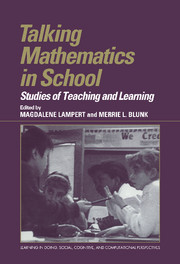Book contents
- Frontmatter
- Contents
- Series Foreword
- Acknowledgments
- List of Contributors
- 1 Introduction
- Part I Doing and Learning Mathematical Talk
- Part II Teaching Mathematical Talk
- 6 Investigating Teaching Practice
- 7 The Teacher's Role in Mathematical Conversation: Stepping In and Stepping Out
- 8 Teacher Talk About How to Talk in Small Groups
- 9 Teaching and Learning Politeness for Mathematical Argument in School
- Afterword
- Author Index
- Subject Index
8 - Teacher Talk About How to Talk in Small Groups
Published online by Cambridge University Press: 04 August 2010
- Frontmatter
- Contents
- Series Foreword
- Acknowledgments
- List of Contributors
- 1 Introduction
- Part I Doing and Learning Mathematical Talk
- Part II Teaching Mathematical Talk
- 6 Investigating Teaching Practice
- 7 The Teacher's Role in Mathematical Conversation: Stepping In and Stepping Out
- 8 Teacher Talk About How to Talk in Small Groups
- 9 Teaching and Learning Politeness for Mathematical Argument in School
- Afterword
- Author Index
- Subject Index
Summary
The recent trend in mathematics educational reform includes an emphasis on small groups. Lindquist (1989), for example, argues that the use of small groups in mathematics teaching and learning can encourage verbalization, increase students' responsibility for their own learning, encourage students to work together to build social skills, and increase the possibility of students solving certain problems or looking at problems in a variety of ways. Indeed, some researchers propose that it is only through communication and participation in a community that novices learn what it means to be a member of that community (Lave & Wenger, 1991).
While a great deal of research has been done investigating the learning that occurs within small groups and the various factors that influence this learning (e.g., Palincsar & Brown, 1984, 1986; Palincsar, 1986; Yackel, Cobb, & Wood, 1991; Russell, Mills, & Reiff-Musgrove, 1990; Johnson, Johnson, & Skon, 1979; Webb, 1983; Cobb, 1995, to name but a few), there have been few studies which have investigated the teacher's role in small groups. Studies that describe small group formats used by teachers and that identify effective small group instructional processes are practically nonexistent (Good, Grouws, Mason, Slavings, & Cramer, 1990). One such area that deserves further attention is the teacher's role in creating and maintaining effective small groups.
Can fifth graders learn to work productively with peers without the direct supervision of the teacher?
- Type
- Chapter
- Information
- Talking Mathematics in SchoolStudies of Teaching and Learning, pp. 190 - 212Publisher: Cambridge University PressPrint publication year: 1998
- 2
- Cited by



